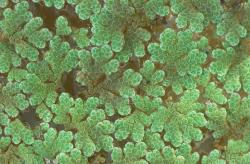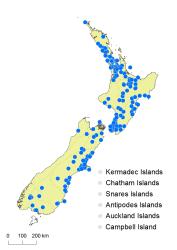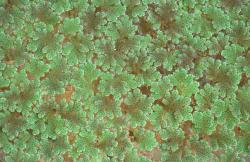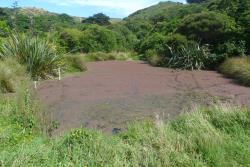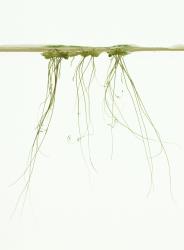- Taxon
- Gallery
- ≡ Azolla filiculoides var. rubra (R.Br.) Strasb., Über Azolla 78 (1873)
Aquatic fern, free-floating, forming extensive red or green mats. Plants broadly ovate, elliptic or broader than long in outline, 6–30 mm long, 5–40 mm wide; stems irregularly branched; roots simple, 5–70 mm long. Leaves densely imbricate; upper lobe of leaves ovate, broadly ovate or broader than long, 0.5–2.0 mm long, 0.5–1.5 mm wide, red or green, papillate; apices obtuse to rounded; margins membranous and translucent. Sporocarps rarely produced; megasporocarps oblong-conical, c. 0.5 mm long; microsporocarps spheroidal, covered in a membranous indusium, 1.0–1.5 mm long, apiculate; both glabrous.
Azolla rubra is readily distinguished from A. pinnata by its irregular branching and by its roots that lack fine rootlets. Azolla rubra is currently the only species that occurs in the South Island, but the southward spread of A. pinnata into the Wellington region suggests that it may soon cross Cook Strait.
North Island: Northland, Auckland, Volcanic Plateau, Taranaki, Gisborne, Southern North Island.
South Island: Western Nelson, Sounds-Nelson, Marlborough, Westland, Canterbury, Otago, Southland, Fiordland.
Altitudinal range: 0–800 m.
Azolla rubra occurs in scattered lowland areas of Northland, where it is being replaced by the naturalised A. pinnata. It is more common through Auckland, Waikato, the Bay of Plenty south to Lake Taupō, and in the southern North Island. On the east coast it has been collected as far north as Māhia, but is apparently absent from much of the East Cape district. It is also absent from much of Taranaki. It occurs most frequently in lowland areas up to c. 300 m but reaches almost 800 m in the Kaimanawa Mountains. In the South Island it is largely confined to lowland areas east of the main divide, extending westwards to near Karamea in the north, and Lake Manapouri in the far south. It extends from sea-level to c. 550 m near Lewis Pass.
Also Australia (all States), and probably Papua New Guinea, Indonesia and Japan (Reid et al. 2006).
Occurs on slow moving streams, ponds, lakes and swamps, and in farm ponds, ditches and drains where it forms extensive red mats of vegetation. It often occurs with species of Spirodela, Wolffia, Lemna, Landoltia, Ludwigia and Potamogeton, and occasionally with A. pinnata, sometimes amongst Typha orientalis, Carex secta or Salix species, or on open water.
No count has been made from New Zealand material of Azolla rubra, but 2n = 44 has been reported for Australian material (Tindale & Roy 2002).
In New Zealand, this plant was treated as A. rubra by Allan (1961) and by all previous Flora writers. However, following Svenson (1944), the name A. filiculoides was adopted for the New Zealand plant by Brownsey et al. (1985) and Brownsey & Smith-Dodsworth (2000), and for the Australian plant by Chinnock (1998). In a detailed investigation of the genus, Reid et al. (2006) showed that A. filiculoides and A. rubra can be distinguished on both morphological characters and molecular differences. Metzgar et al. (2007) confirmed that the two are closely related sister taxa that are themselves sister to a clade containing the remaining American species. The name A. rubra was therefore reinstated by Brownsey & Perrie (2013) as a species native to Australia and New Zealand, and sister to the American A. filiculoides.



